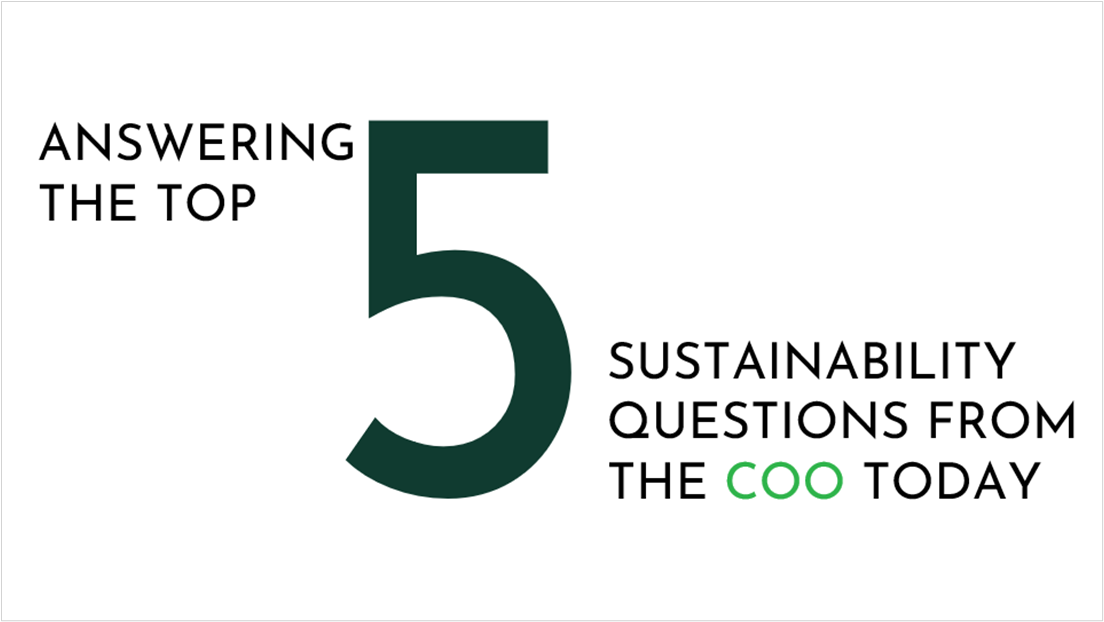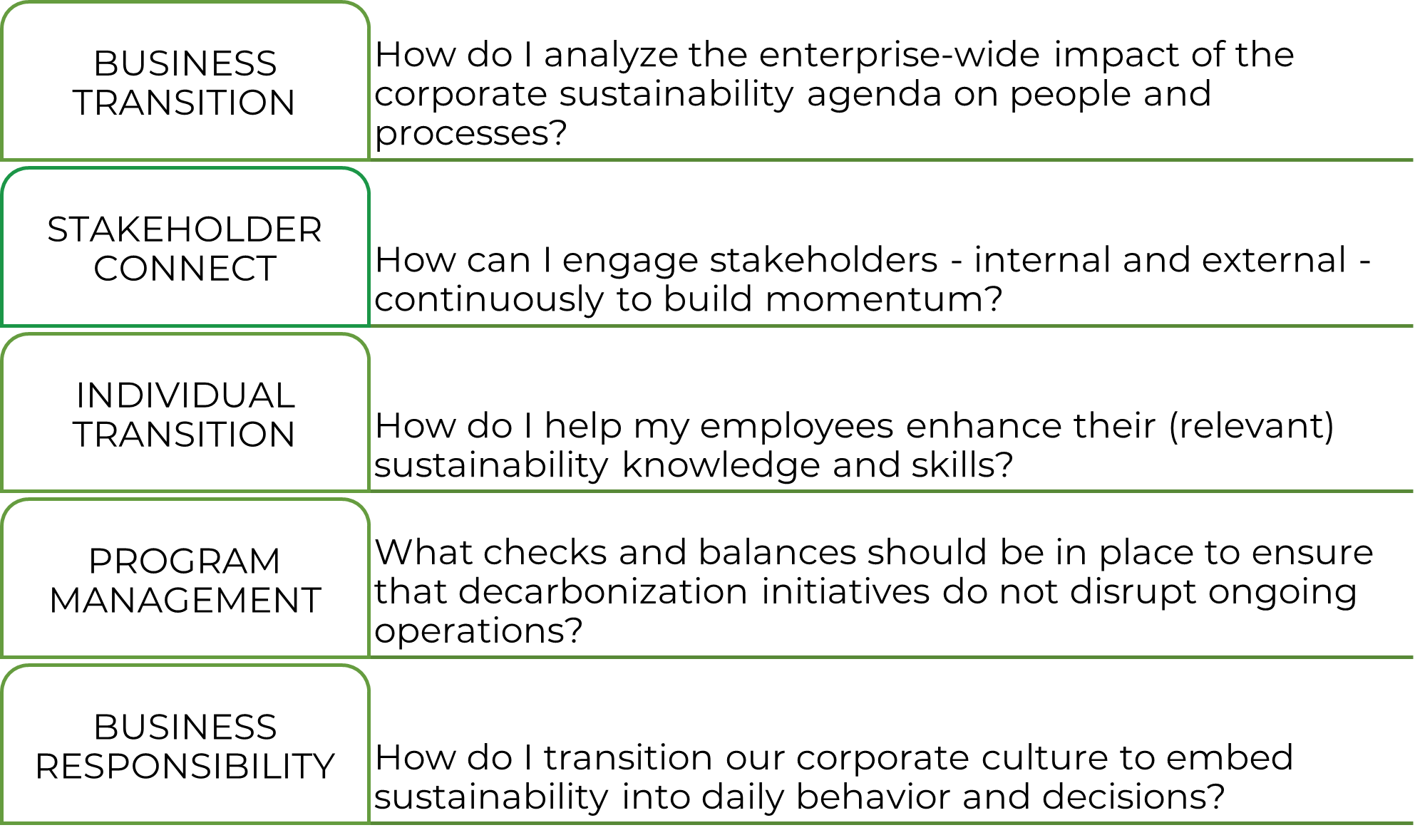
People and Processes are at the heart of any enterprise-wide program and this is no different with the Sustainability agenda. It is the responsibility of the leadership team to drive the program in a manner that neither of them is impacted negatively. As the steward for operationalizing the business strategy, this responsibility sits squarely on the shoulders of the Chief Operations Officer (COO).
From establishing the right policies to evolving the right KPI framework, From daily operational procedures to performance monitoring – there are multiple (and equally-significant) avenues to embed the sustainability agenda across the enterprise. For effective implementation of this complex program, a few important boxes need to be ticked.

1. How do I analyze the enterprise-wide impact of the corporate sustainability agenda on people and processes?
With each passing day, one hears about businesses exploring possible avenues to green their product/service offerings. This could be by introducing a completely new line of offerings, by innovating greener variants of un-substitutable products, by revamping the existing business processes, and a lot more. From large behemoths to smaller enterprises, transitioning to a Low Carbon Economy carries significance to everyone. At the same time, these transitions cannot happen without a thorough understanding of their impact on the people involved across the operations.
We propose a systems thinking approach should be taken to implement the sustainability roadmap, so that every potential change or rewiring exercise in this transitional journey is analysed thoroughly. Due consideration must be given to the multi-stakeholder, multi-dimensional and multi-year aspects of business transition to identify the impact they would have on people and processes. Further, aligning this analysis with business strategy is key. Establishing these safeguards upfront gives your business the best chance of winning the confidence of your teams, while lowering the resistance to change.
2. How can I engage stakeholders - internal and external - continuously to build momentum?
Enterprises today operate in a multi-stakeholder environment to manage their end-to-end operations. From employees across the hierarchy to partners across the value chain, it is important to have a constant awareness of their pulse. For businesses that intend to adopt Sustainability as a strategic imperative, the challenge of keeping everyone abreast and enthused is key. Catching them unaware about this transition will prove detrimental to the overall morale and the ongoing efforts, even if they were executed with the best of intentions.
At the outset, we suggest that strong and active communication lines are established with your stakeholders. It is also important to give them enough avenues to participate in the various initiatives – from seeking ideas to implementing them, your people can bring a lot to the table. We propose educative, explorative, participative and communicative techniques are explored cohesively to aid the imperative shift in the enterprise culture as well.
3. How do I help my employees enhance their (relevant) sustainability knowledge and skills?
Corporate sustainability initiatives hinge their chances of success heavily on the support and momentum from employees across the organization. This calls for every individual across the organization to be sensitized on the subject of sustainability. This includes the life of employees both at work and beyond it, and their incentive to progress towards becoming more sustainable.
We believe this is an area that needs one to be contextual. We propose you draft your plans to achieve twin objectives:
- As an employee, each person has to relate to the subject of sustainability in his/her work environment.
- As an individual, each person has to relate to the relevance of sustainability in their daily lives.
This can be embedded into your employee learning plans, as organizations are expected to bridge the sustainability skill gap rather quickly.
4. What checks and balances should be in place to ensure that decarbonization initiatives do not disrupt ongoing operations?
When business ambitions like Net Zero are put to action, it translates into a multi-year, multi-stakeholder program. All such programs are highly complex in nature considering the number of variables involved. Enterprises need to consider how this complex program is structured, from clear definition of the roles and responsibilities to managing and monitoring the risks and processes. At the same time, the practicalities of limited resources, inefficient practices and a high reliance on external expertise can compound the challenges.
We suggest that you establish a strong set of guidance to ensure that the initiatives are executed effectively and efficiently. Some of the guidance techniques would be – calling out roles and responsibilities clearly, maintaining transparency in the program schedule, communicating regularly with involved parties, managing program risks diligently. It must be appreciated that long-running programs like these could be affected by external factors that are beyond your control (ex: regulatory changes). This requires you to manage the impact of these changes, such that the operational teams are supportive rather than resistive.
5. How do I transition our corporate culture to embed sustainability into daily behavior and decisions?
Every department – Manufacturing, Marketing, HR, Finance, Customer Service, R&D, Legal and more - within the enterprise has to rewire and add sustainability into their DNA. Every individual must relate to the corporate sustainability roadmaps and initiatives. This is one subject that should not come across as something conceived in an ivory tower. It must be relatable to everyone because it impacts everyone – professionally and beyond. It is important to embed sustainability into the corporate culture by default.
We suggest a continuous and ongoing sensitization to the subject is needed to ensure that this stays on top of the agenda, as teams and individuals get busy with their daily responsibilities. Walking the talk consistently is the best way to demonstrate what this means for the organization – the fact that it is a matter of principles. Techniques like gamification, hackathons, workshops should be explored to bring up the subject in a relatable way. It is all about leveraging the popular methods of people engagement, in a new way.
It is a given that the COO’s role requires outstanding organizational and leadership abilities. With businesses making sustainability integral to their strategy, it is these abilities that will come to the fore and translate the strategy into action. In effect, the COO must succeed in this mission to help accomplish the CEO’s agenda and the CSO’s agenda. A lot is riding on the COO.
